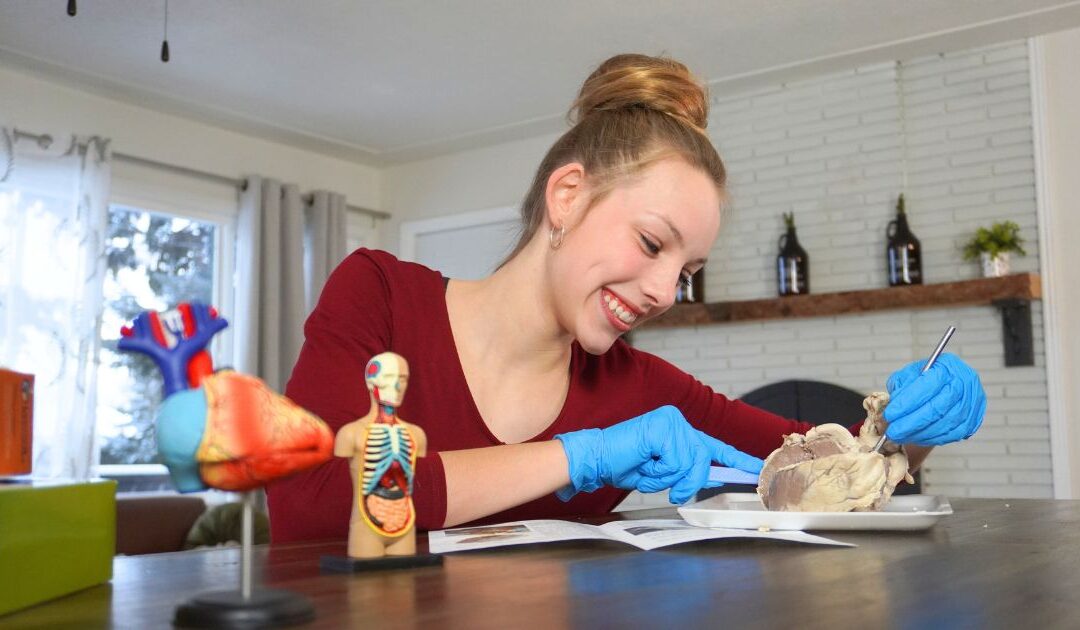So you’re interested in microscope activities because… you have a microscope. What next?
With the directions here and in our Introductory Microscope Experiments Science Project, you can get started right away making your own microscope slides!
Make your own prepared slide with mounts of your choice of specimen on glass microscope slides.

This is a great microscope activity for junior high to high school age.
Or make simple slides out of household items, a project that works well for elementary age kids and can be used with both compound and stereo microscopes.
Cork Cells Under the Microscope
In the late 1600s, a scientist named Robert Hooke looked through his microscope at a thin slice of cork.
He noticed that the dead wood was made up of many tiny compartments, and upon further observation Hooke named these empty compartments cells.
It was later known that the cells in cork are only empty because the living matter that once occupied them has died and left behind tiny pockets of air.
You can take a closer look at the cells, also called lenticels, of a piece of cork by following these instructions.
Materials Needed:
- a small cork
- plain glass microscope slide
- slide cover slip
- sharp knife or razor blade
- water
How to make the microscope slide:
Carefully cut a very thin slice of cork using a razor blade or sharp  knife (the thinner the slice, the easier it will be to view with your microscope).
knife (the thinner the slice, the easier it will be to view with your microscope).
To make a wet mount of the cork, put one drop of water in the center of a plain glass slide – the water droplet should be larger than the slice of cork.
Gently set the slice of cork on top of the drop of water (tweezers might be helpful for this). If you are not able to cut a thin enough slice of the whole diameter of the cork, a smaller section will work.
Take one cover slip and hold it at an angle to the slide so that  one edge of it touches the water droplet on the surface of the slide.
one edge of it touches the water droplet on the surface of the slide.
Then, being careful not to move the cork around, lower the cover slip without trapping any air bubbles beneath it.
The water should form a seal around the cork. Use the corner of a paper towel to blot up any excess water at the edges of the coverslip.
To keep the slide from drying out, you can make a seal of petroleum jelly around the cover slip with a toothpick.
Begin with the lowest-power objective to view your slide. Then switch to a higher power objective to see more detail. Use this same wet mount method for the other cell specimens listed below.
- Find out how to make a smear of cheek cells, observe root and stem sections, and look at leaf cells under high power. Get directions here for making these slides.
For information of choosing the microscope that is right for your family, take a look at our How to Select a Compound Microscope article.
Learn more about using your compound microscope by making simple slides using common items from around the house!
(Note: This Science Lesson was written for use with a compound microscope; however, the technique can be easily adapted for use with a stereo microscope and dissecting microscope as well.)
Making Simple Slides
Materials Needed:
- Clear Scotch tape
- A few granules of salt, sugar, ground coffee, sand, or any other grainy material
- compound microscope
To make a slide, tear a 2 ½-3” long piece of Scotch tape and set it sticky side up on the kitchen table or other work area.
Fold over about ½” of the tape on each end to form finger holds on the sides of the slide.
Next, sprinkle a few grains of salt or sugar in the middle of the sticky part of the slide. You can repeat this with the other substances if you like, just be sure to label each slide you make with an  ink pen or permanent marker so you will know what’s on the slides!
ink pen or permanent marker so you will know what’s on the slides!
(Note: Because there are several suggestions for things that can be done with these homemade slides throughout this article, you might want to make several slides at once so that you have them ready.)
- For more slide making ideas, read our Introductory Microscope Experiments science project.
How to Use the Microscope
Place one of your homemade slides on the center of the microscope’s stage, directly over the clear hole.
Put one stage clip on one edge of the slide to hold it in place leaving the other end free to move around.
Turn your microscope’s light source on, lower the stage, and position the lowest power objective lens over the slide.
Looking through the eyepiece, turn the coarse focus knob until the outlines of the granules become visible.
Then turn the fine focus knob to get the image as sharp and clear as possible. Because the tape is thinner than glass microscope slides, you may have to move the slide around some to focus it better – try slightly lifting it up or pressing it down with your fingers.
The basic shape of the crystals should be visible at 40x. Now turn the nosepiece so the 10x objective (100x magnification) is positioned over the stage.
Most compound microscopes are parcentered and parfocal.
Parcentered means that if you centered your slide while using one objective, it should still be centered even when you switch to another objective.
Parfocal means that once you have focused on an object using one objective, the microscope will still be coarsely focused when you switch to a different objective. Because of these features, you should only need to turn the fine focus knob slightly and perhaps move your slide a tiny bit to make sure it is centered and well focused under the new objective lens.
As you slowly turn the fine focus knob you are actually moving in and out of many layers of the specimen, which is why some parts in the field of view may look blurry while some are sharp. This is simply because you are looking at a three-dimensional object and at high magnification the different layers seem much larger than they would without the magnification, even in tiny single-celled organisms!
Compare the shapes, sizes, and colors of the crystals on each of the slides you made. Record your observations on a sheet of paper or in your science notebook. Include information about the slide such as the date, what it is, the magnification level used, and perhaps even a drawing. You can also print out copies of our Microscope Observation Sheets to put in your science notebook.
Microscope Worksheet: How to Record Observations
In the field of science, recording observations while performing an experiment is one of the most useful tools available.
Early scientists often kept very detailed journals of the experiments they performed, making entries for each individual experiment and writing down virtually everything they saw.
These entries often included drawings and detailed descriptions as well as the procedures they used, the data they collected, and conclusions drawn from their experimentation.
Our printable Microscope Observation worksheets will help you keep track of the things that you study with your microscope and remember what you have learned. Blanks are provided for recording general information about each slide, such as the date it was prepared and the stains used, as well as space to write down your observations and circles to do sketches of what you see.
Click here to print out copies of the Microscope Observation worksheet!






